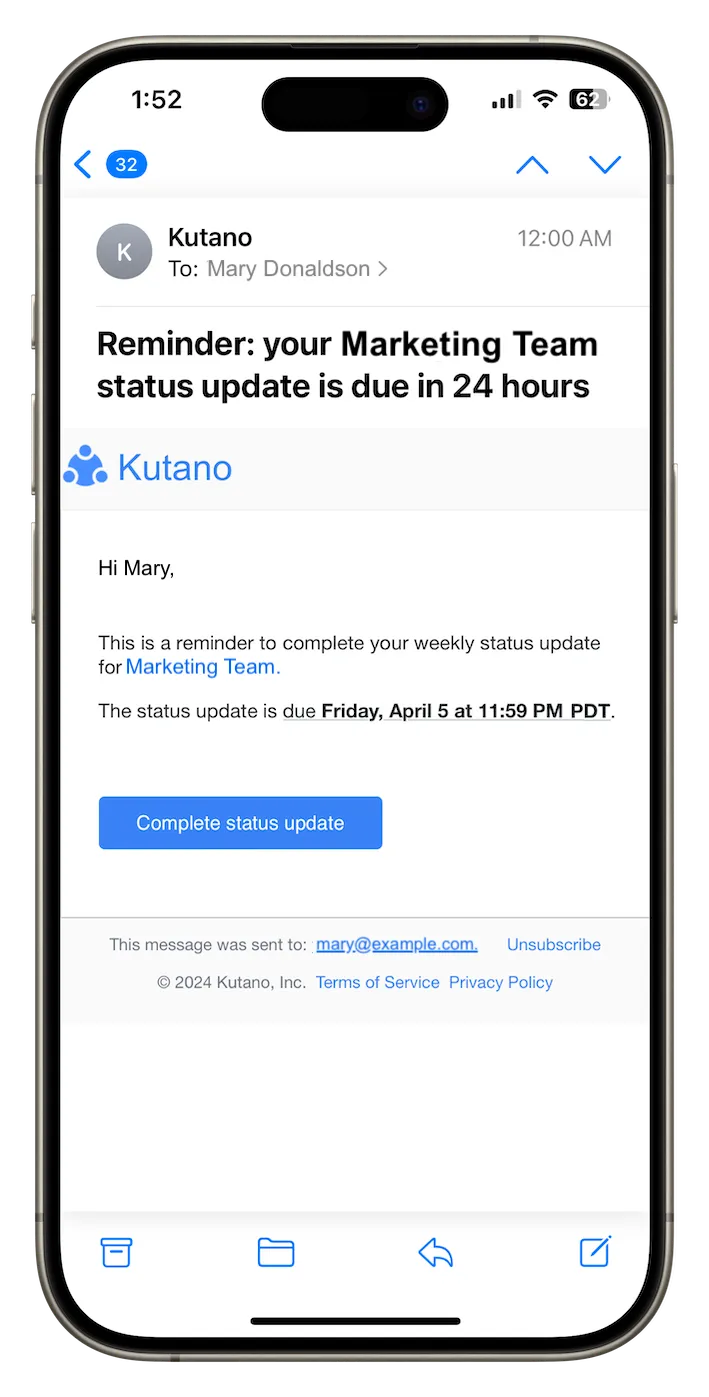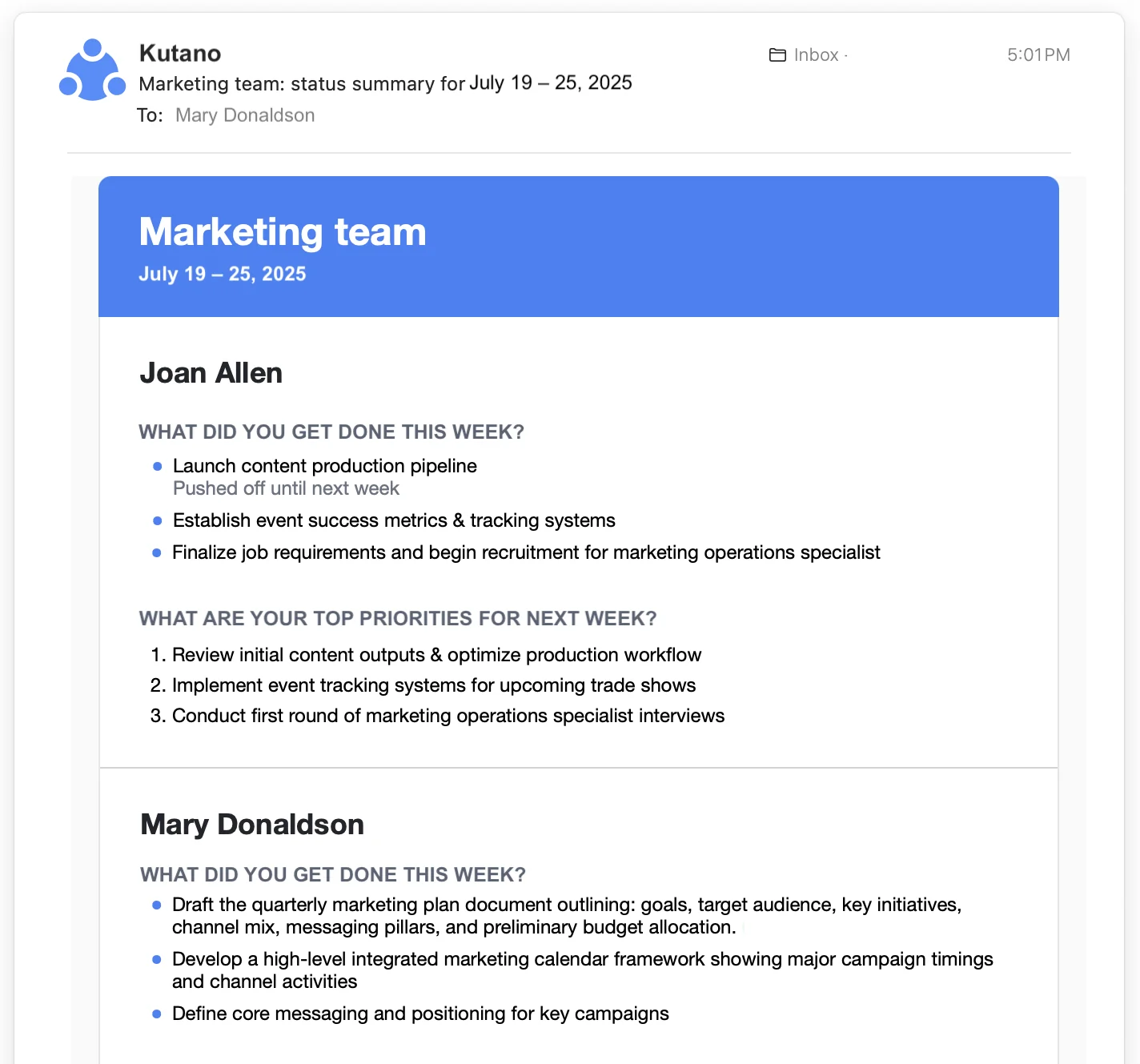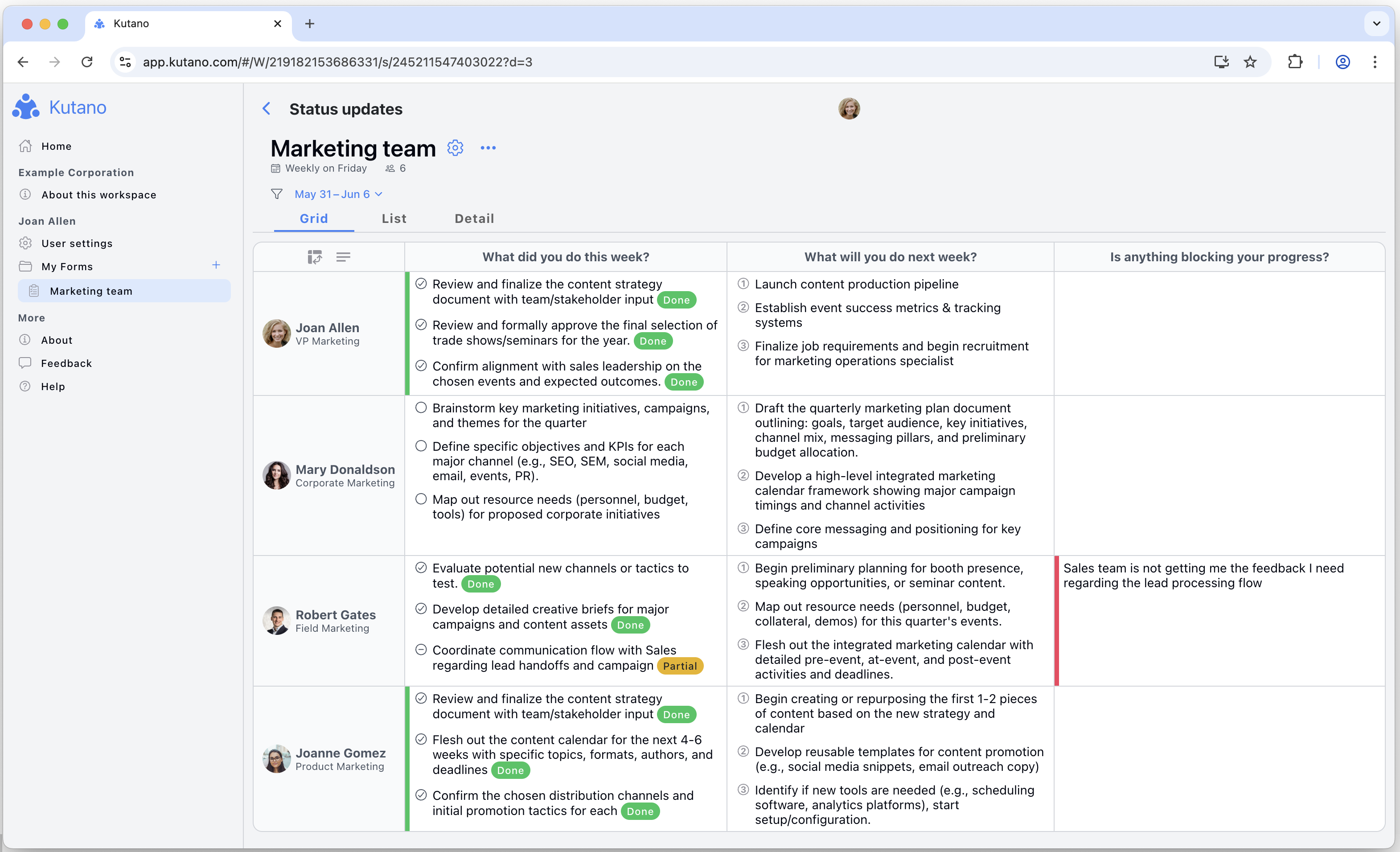How Kutano Works - Weekly Status Update Process
How many hours did your team spend in status meetings last week?
If you're like most teams, it was probably 2-4 hours—time that could have been spent on actual work. Kutano replaces those time-consuming status meetings with an incredibly lightweight process that takes just minutes each week, giving you back precious hours while keeping everyone better informed than ever.
The best part? There's virtually no learning curve. If your team can send emails, they can use Kutano.
The Problem with Traditional Status Meetings
Before we dive into how Kutano works, let's be honest about what you're dealing with right now:
- Time drain: Status meetings typically consume 1-2 hours per week of everyone's time
- Scheduling nightmares: Getting everyone in the same room (or Zoom) at the same time
- Information overload: Sitting through emails and Slack messages that could have been summarized in a few bullet points
- Lack of clarity: Everyone leaves the meeting with a different understanding of what was discussed
- No paper trail: "Wait, what did Sarah say about that project last week?"
Sound familiar? You're not alone. This is exactly why teams are switching to Kutano's async approach.
The Weekly Update Cycle
Here's the ridiculously simple three-step weekly process that typically saves teams 2-3 hours every week. No training required, no complex setup, no IT headaches:
1. Friday morning: We send gentle reminders (so you don't have to)
- Team members receive an email with a direct link to their status update form
- One click takes you straight to where you need to update—no hunting through bookmarks or remembering URLs
- No more chasing people down or sending "friendly reminder" messages
2. By Friday evening: You quickly share updates (and actually get home on time)
- Members complete their updates in under 10 minutes—faster than most coffee breaks
- Information flows into a simple, customizable form that adapts to your team's unique needs
- Updates are due by end of day Friday, giving everyone a clean slate for the weekend
- No more "quick 30-minute status meeting" that somehow becomes an hour
3. Monday morning: You get a complete team picture (without the meeting hangover)
- Everyone receives a consolidated report showing the entire team's status—no more playing catch-up
- See what everyone accomplished and what's coming next, all in one place
- Add comments or reactions to collaborate on priorities without scheduling another meeting
- Start your week informed and focused, not scrambling to remember what was discussed
What Is a Status Form?
Think of a Status Form as your team's mission control center—but without the stress and complexity. It's the central tool in Kutano that collects everyone's updates and transforms scattered information into crystal-clear team insights.
Here's what changes: Instead of hunting through email threads, Slack messages, and half-remembered conversations, you get one organized view of who's doing what, when, and why. No more "Did anyone catch what Mike said about the Johnson project?" moments.
The genius is in the simplicity: It's just a form. Everyone knows how to fill out a form. No new software to learn, no complex workflows to master, no lengthy onboarding sessions.

Key Features That Actually Matter
- Dead Simple Structure: Each team member gets their own column—no confusion about who said what
- Zero Learning Curve: Skip the generic templates. Collect exactly the information your team needs, nothing more, nothing less
- Effortless Accountability & Oversight: Automatic saving of past updates creates an instant, searchable audit trail of progress, commitments, and challenges—vital for performance tracking, strategic planning, and knowledge retention.
- Instant Team Visibility: Everyone sees the big picture of team activities—no more information silos or surprise project conflicts
- Works Everywhere: Complete updates from anywhere, anytime—no special apps to download or software to install
What You Can Track (It's Up To You)
The beauty of Kutano is that it adapts to how your team actually works. You're not forced into someone else's idea of what a status update should look like. Common things teams track:
- Goals and objectives
- Weekly accomplishments
- Key metrics and KPIs
- Challenges and blockers
- Upcoming priorities
- Resource needs
- Client updates
- Budget status
Each team can use a pre-built template or create a custom form that collects exactly what you need. Marketing teams track campaign performance. Development teams track sprint progress. Sales teams track pipeline updates. The form adapts to you, not the other way around.
The Process in Detail
Step 1: Reminder Email (No More Nagging Required)
Team members receive a simple, clean email reminder with a prominent button—no confusing links or complicated instructions.

Clicking "Complete status update" takes you directly to your form - no need to search through emails or remember URLs. It's so simple, even the most tech-resistant team members can handle it without calling IT.
Step 2: Submit Your Update (Seriously, It's That Easy)
The status update form is designed to be completed in less than 10 minutes on any device. We've obsessed over making this as painless as possible—because if it's hard to use, people won't use it.
On desktop:

On mobile:

Whether you're grabbing coffee, commuting, or working from your couch, the form works flawlessly. No downloads, no special apps, no training videos. Just fill it out and you're done.
Step 3: Review the Team Summary (The Part That Actually Changes Everything)
After everyone submits their updates, Kutano compiles them into a comprehensive team report that lands in your inbox Monday morning—coffee-ready and agenda-free.

This report gives everyone the visibility that usually requires three meetings and a dozen Slack threads:
- What each team member actually accomplished (no more "I think Sarah was working on that project?")
- What's being prioritized for the coming week (so nothing important gets forgotten)
- What challenges the team is facing (before they become full-blown fires)
The real magic happens when you realize you can scan this entire report in 5 minutes and be more informed about your team's status than you were after an hour-long meeting. That's the power of structured, written communication.
Accessing Past Updates
You can view your team's current and past status updates anytime through the Kutano web application.

This creates something most teams desperately need but never have: a searchable, organized historical record. Think about it—when was the last time you could quickly answer "What did we accomplish in Q2?" or "When did that project actually start?"
Here's what this historical record actually does for you:
- Track progress on long-term goals (and prove you're not just spinning your wheels)
- Ensure nothing falls through the cracks (because someone will always remember to ask about it)
- Review past challenges and solutions (so you stop solving the same problems over and over)
- Demonstrate accomplishments over time (especially handy during performance reviews or client check-ins)
- Onboard new team members faster (they can see the context behind current projects)
The Real ROI: What This Means for Your Team
The Tangible Returns: More Than Just Time Saved
Let's talk numbers for a moment. If your team of 8 people spends 90 minutes in a weekly status meeting, that's 12 hours per week, 48 hours per month, or 576 hours per year. At an average salary of $75/hour (loaded cost), you're spending $43,200 annually just on status meetings.
With Kutano:
- Each person spends 10 minutes per week updating = 80 minutes total for the team
- Reading the consolidated report takes 5 minutes per person = 40 minutes total
- Total weekly time investment: 2 hours vs. 12 hours
- Annual savings: $38,400 and 480 hours of productivity
But here's what you can't put a price on: the reduction in stress, the improved team alignment, and the satisfaction of actually having a record of what your team accomplishes.
Think about it this way: What could your team do with an extra 480 hours per year? That's equivalent to hiring another team member for 3 months. Or finally tackling that backlog project. Or actually taking a vacation without worrying about what you missed.
Making Updates Easier: Smart Carryover (Because Simple Should Get Simpler)
We know that filling out the same form every week can be tedious. That's why Kutano gets smarter over time. When it's time for your next update, Kutano automatically carries forward relevant information from your previous update. This means:
- Ongoing goals and metrics are pre-filled
- You only need to update what has changed
- Long-term projects stay visible week-to-week
- The process gets faster and easier over time
By week 3 or 4, most people can complete their updates in under 5 minutes. The system learns what matters to your team and helps you focus on what's new, not what's the same. It literally gets easier the more you use it.
Ready to Get Your Time Back?
This simple, consistent process helps teams stay aligned without wasting time in status meetings. You'll wonder how you ever managed without it—and more importantly, your team will thank you for finally solving the status meeting problem.
"But what if my team resists change?"
As a leader, you understand that implementing positive change, even one as simple as Kutano, can sometimes meet initial friction. Kutano is designed to make this transition virtually effortless. Team members quickly realize they're swapping hours of meetings for minutes of focused updates, gaining clarity and reclaiming their time. The resistance to 'another tool' fades when they experience a process that demonstrably makes their work lives easier, more productive, and empowers them with better information.
Here's what happens next:
- Start your free trial - Set up your workspace in under 5 minutes (seriously, it's that fast)
- Customize your first status form - Use a template or build your own from scratch (takes 2 minutes)
- Invite your team - Just add their email addresses. They'll receive their first update reminder automatically
- See the difference immediately - Your first Monday morning report will show you what you've been missing
No IT required. No training needed. No complicated setup. The teams that make the switch typically see results in their very first week. Less time in meetings, better team alignment, and finally—a process that actually works.
Still on the fence? Remember: you're not just buying software, you're buying back time. Time to focus on work that matters. Time to go home on schedule. Time to actually think strategically instead of just keeping up with what everyone's doing.
The cost of doing nothing is higher than you think. Every week you delay is another 2-4 hours of your team's life spent in meetings that could be emails. Another week of scattered information and missed opportunities. Another week of ending Friday wondering what everyone actually accomplished.
Start your free trial today and join teams who've already reclaimed their weekly status meetings.